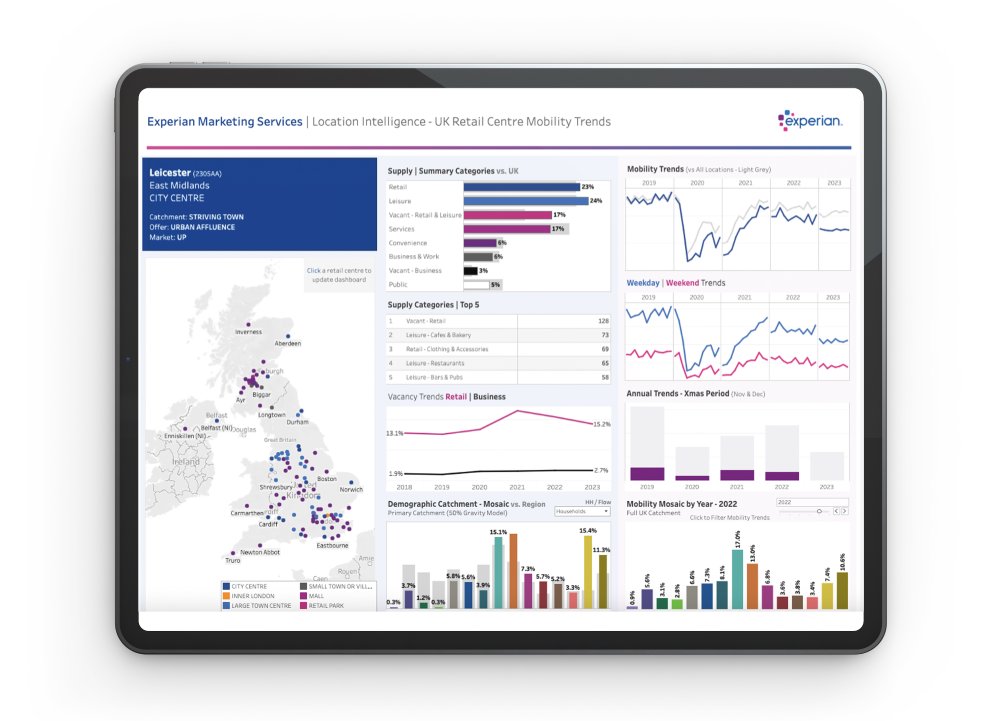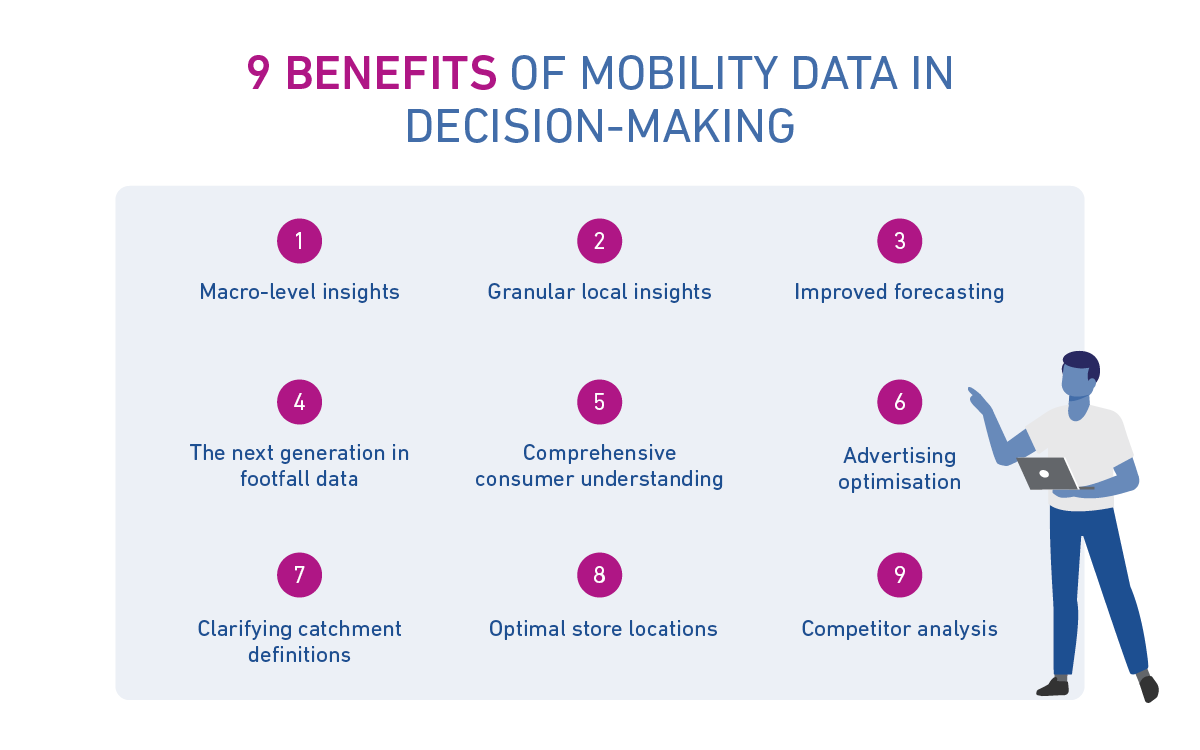Mobility data is reshaping our understanding of consumer behaviour, offering a deeper dive into the daily movements and choices of people.
Location mobility data, from devices like smartphones, reveals how people engage with locations and therefore provides trends in habits, preferences and lifestyles.
The data focuses on preserving the anonymity of individuals while aiming to uncover trends on a broader scale. Equipped with these insights, businesses can unlock a deeper view of their market, understanding trends and patterns that were previously hidden. A powerful array of insight to support business decision-making.
What is mobility data?
Mobility data is the collection and analysis of location-based information from personal devices like smartphones. These devices send out a stream of GPS signals which, when pieced together with timestamps, create a comprehensive and dynamic portrait of human mobility: where people are going, when they’re going, and how long they’re staying.
This data is more than just a set of geographical points; it’s a window into the patterns of daily human behaviour. For businesses, it’s an invaluable resource. Mobility data reveals not just locations but also the preferences and behaviours of people: where they spend their time, their commuting habits, and their lifestyle choices.
This can inform areas like marketing campaigns and product placement, ensuring that strategies are based on real, up-to-date consumer behaviour data.
What information is gathered for businesses?
To harness the insights of mobility data, a variety of information is collated that informs the vast datasets produced. It’s predominantly quantitative data, protecting individual anonymity by seeking to identify trends and patterns on a larger scale. It covers various aspects of consumer movement, including:
- Time of visit: Is a visit in the morning, afternoon, or evening? Is it at the weekend or during the working week?
- Dwell time: How long do people stay in one place? Is it a transient location, like a train station, or somewhere they will spend a few hours?
- Origin of visitor: How far have they travelled to reach their destination?
- Location of visit: Where are they visiting when they’re within a certain geofence (a virtual perimeter for a geographic area)?
- Flows and journeys: What are the flows from a particular retail store to other affinity locations within the same trip?
With this array of data, the insights start to create a digital tapestry of human movement to provide a greater understanding of their needs and products they may be interested in. This is mobility data in action: vibrant, multi-layered, and essential for companies navigating the ever-changing consumer landscape with confidence.
The importance of demographic data in mobility analysis
While mobility data alone provides valuable insights into the volume and patterns of movement, it often lacks the critical element of demographic information. It’s this critical element that provides insight into the wider needs and/or interests of people engaging with locations.
By incorporating demographic insights, businesses can gain a more comprehensive understanding of mobility behaviours, enabling them to tailor services and strategies to meet the specific requirements of various population segments. Without demographic data, businesses risk overlooking crucial nuances in mobility demand, hindering their ability to effectively address diverse needs and behaviours.
What does mobility data look like?
Mobility data could be the poster boy for Big Data – incredibly large and varied sets of data that need more than your average spreadsheet formula to analyse. So, once the data is collected, these large-scale datasets of human mobility are mined to recognise patterns and insights. That way, when it reaches the businesses that can utilise the data, it looks more like:
- Visitor reporting: The number of visitors within a specific geofence (a virtual boundary). This can be as granular as hourly data, so you can see visitor numbers during days and times in the week.
- Dwell-time analysis: How much time visitors are spending in each boundary.
- Demographic profiling: Data segmented by demographic, such as age, income, gender or occupation, to comprehensively profile the behaviour patterns of certain groups.
- Geographical origin metrics: The amount of visitors coming from different locations – this is available from as micro as local, and as macro as national. Through this, you can begin to map catchment areas.
- Pedestrian flow monitoring: Pedestrian numbers on roads and pathways.
- Footfall drivers identification: A step beyond footfall metrics, mobility data recognises the most frequently visited spaces within geofences to understand why people are visiting an area, not just how many.
The image below gives a view of the vast array of data and insight available to see in our Mobility Trends Dashboard. If you’d like to see a demonstration of this, do get in touch.

The benefits of mobility data in decision-making
- Macro-level insights: Mobility data enables fast access to macro-level insights and overarching trends, so businesses can understand how locations are performing and compare them against each other.
- Granular local insights: On a localised level, mobility data offers detailed information into specific areas, like changes on a particular street where a business operates, and how this has impacted a product line.
- Improved forecasting: More and more, we’re seeing quick behavioural shifts amongst consumers. Because of this, the traditional method of forecasting from historical data is becoming less accurate. Mobility data gives businesses access to present data for more reliable forecasting.
- The next generation in footfall data: Mobility data goes beyond footfall counts, offering insights into how demographics are changing and interacting with different spaces, creating fuller consumer profiles.
- Comprehensive consumer understanding: Combining mobility data with demographic information provides a complete picture of who in the demographic is visiting a location, why they are there, and their behaviours so businesses can craft hyper-targeted strategies.
- Advertising optimisation: Armed with the rich insights that mobility data provides, you can get to know where your target demographic will be and when, ensuring ads reach the right audience at the right time.
- Clarifying catchment definitions: Mobility data helps in gauging travel distances and identifying emerging trends, essential for understanding a business’s catchment area.
- Optimal store locations: You’ll know the best locations for new stores based on target audience traffic, so you can trust that you’ll be right where your customers are.
- Competitor analysis: Understanding visitor share and dwell times provides a competitive edge, allowing businesses to see how they stack up against others in their sector.

Top tips when using mobility data
Stay ahead with location planning
The consumer landscape is incredibly dynamic, and things change quickly. So when it comes to location planning, you need to have your finger on the pulse by utilising only the most up-to-date datasets. This is true for both occupiers and businesses running outdoor advertising campaigns.
For example, you may be excluding a certain street from your ad campaigns because previous data has shown that your target demographic doesn’t visit that area. However, the last 12 months may have seen two or three establishments open that your target demographic is interested in, and now they visit that street daily. If your data is even one or two years old, you may fall behind, and your competitors may not.
Get granular with data
Granular data is essential for both macro and micro-level decision-making. It’s important to look beyond aggregate footfall numbers and delve into detailed interactions at different times and days. This level of detail can inform how you position your brand and tailor your approach to different visitor segments.
Align with the right partners
When integrating a new dataset like mobility data, partner with a business that understands its commercial use and application. The right partner can help you transform insights into actionable strategies to guarantee that the data is leveraged effectively for decision-making.
Aligning with the right partner will also ensure that the correct due diligence is completed so that only information that has been covered under a robust consent management framework is collated and that data is anonymised and used in an aggregated format.
Think outside the box
Encourage creative thinking in how mobility data can be utilised across your business. From site selection and marketing to reshaping internal operations, there’s a wealth of ways to apply this data innovatively. Questioning and exploring its potential will unlock new opportunities and enhance various business aspects.
Exploit insights across the organisation
Used creatively, mobility data can inform internal operations too, like HR strategies. For instance, understanding employee commuting patterns and preferences can lead to more supportive workplace policies. This holistic application of mobility data across the organisation allows you to extract maximum value and foster a comprehensive understanding of both customers and employees.
Emerging trends in mobility
The patterns of consumer mobility and behaviour are forever changing. Driven by a multitude of causes, from technological progress to events like the pandemic, the emerging mobility trends we’re seeing show that the way people interact with their local environments, city centres, and retail spaces is changing.
Shift in local interactions and retail engagement
The way consumers interact with their local areas and retail environments has seen a significant transformation. Initially driven by the rise of online platforms, which shifted purchase behaviour, the pandemic further accelerated these changes. Businesses are now observing a change in consumer patterns, particularly in how consumers engage with local retail spaces, with the digital world evermore readily at their fingertips.
Working from home and local tourism
The increase in home working has led to a notable decline in the number of working professional visitors in city centres. This has affected businesses that previously catered to this demographic. However, armed with the right data, businesses can pivot their strategy to ensure they still reach this customer base (which mobility data tells us are now spending more time in their local communities).
Just as the pandemic led to more home working, it also influenced local tourism, with more people choosing to holiday within the UK. These changes have profound implications for how businesses approach physical occupancy, marketing, and advertising, and real-time mobility data is key to adapting.
Family presence and younger visitors in city centres
While professionals are spending less time in city centres, families and younger visitors are spending more than previously. With this knowledge, businesses can adjust their strategy to cater to these new visitor profiles. Over time, we may start to see a significant change in the business focuses in city centres.
Businesses need to be agile in understanding where their customers are now spending their time. By leveraging mobility data, they can reassess their location strategies to capture spending from these evolving visitor demographics, making sure they remain relevant and profitable in a rapidly changing market.
Elevate campaigns by understanding the ‘who’ in mobility data
Understanding the intricate relationship between places and people is crucial for success. Mobility Insights is your key to unlocking these insights, aggregating big mobility data to create a digital tapestry of consumer insights.
It goes beyond mere location mapping, integrating geolocation data with our leading Mosaic segmentation. It’s not just about tracking where interactions occur; it’s about understanding who is behind these interactions.
Mobility Insights empowers you with rich demographic insights so you can craft marketing and location strategies that resonate with your target audience. Evaluate visitor numbers and dwell times across different times and days, track journeys across locations, experience comprehensive, data-led customer profiling and more. Whether you’re exploring city-wide trends or zooming in on a specific street, enjoy clarity and depth for informed decision-making.
The valuable insights provided through our collaboration with Experian have been instrumental in shaping our growth strategy and contributing to the refresh of our brand. The data-driven approach has allowed us to make informed decisions about our expansion, identify new opportunities, and ensure that our brand evolves in line with our customers’ needs and preferences.
Marie Liston, Corporate Services Director at ScS
Mobility data is a game-changer for business strategy, offering a fresh perspective on consumer habits and movements, providing insights not just into where people are, but who they are.
For businesses, this means strategies grounded in real behaviour, not guesswork. It’s an exploration into the nuances of human interaction with spaces, empowering businesses to navigate the complexities of consumer preferences with confidence and precision. Mobility data is the key to unlocking a deeper understanding of the market, ensuring businesses are not just keeping pace, but leading the way in innovation and consumer connection.
How we can help
Mobility data is the key to unlocking a deeper understanding of the market, ensuring businesses are not just keeping pace, but leading the way in innovation and consumer connection.
Click here to find out more.









